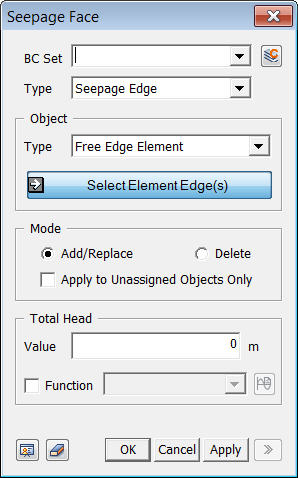Boundary: Seepage Face

Function
Seepage face is a review boundary condition which assigns a total head value to either element edges or solid faces where the flow is outgoing. Depending on the position of the specified water head, if the water head level is above the specified seepage face value, then an iterative solution calculates the unknown phreatic surface. Seepage faces that are specified greater than the specified water level are reviewed internally.
For confined flow, simply specify the total head value.
Call
Model > Boundary > Seepage Face...
|
<Seepage Face>
|
BC Set Select the Boundary Condition Set to be distributed to the current boundary condition to be defined. If there is no pre-defined Boundary Condition
Set, click the Type Seepage Face 2D Select element edge. 3D Select the face of solid element.
Object
Type Choose the basis for selecting the element for defining the seepage face.
Surface Define the seepage face by selecting Surface
Free Face Element Define the seepage face on the relevant face of the solid element's Free Face. Mode
Add/Replace Define a new node discharge or replace an existing node discharge with a new node discharge.
Delete Delete the defined node discharge
When Add is selected and the "Apply to Unassigned Objects Only" is checked, the information for the preexisting element or node is maintained, but if it is unchecked, the newly inputted information is replaced.
Pressure Head
Value Input the pressure value.
Function To use seepage boundary condition function in the unsteady state analysis, click on this option and select the function to use. If a function has not been pre-defined, click on the button on the right and summon the relevant function.
After
all the inputs have been completed, click the preview |

 button to check if the boundary conditions
have been inputted accordingly, and if there are no errors, click the
button to check if the boundary conditions
have been inputted accordingly, and if there are no errors, click the
 button. If user is continuing with inputting boundary
conditions elsewhere, click the
button. If user is continuing with inputting boundary
conditions elsewhere, click the  button and continue inputting information.
To initialize the inputted information click the
button and continue inputting information.
To initialize the inputted information click the
 button and re-input the data.
button and re-input the data.